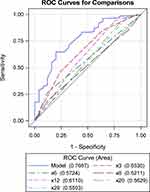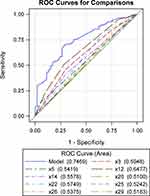Back to Journals » Psychology Research and Behavior Management » Volume 14
Frequent Sports Dance May Serve as a Protective Factor for Depression Among College Students: A Real-World Data Analysis in China
Authors Zhang L, Zhao S, Weng W, Lin Q, Song M , Wu S, Zheng H
Received 7 January 2021
Accepted for publication 4 March 2021
Published 9 April 2021 Volume 2021:14 Pages 405—422
DOI https://doi.org/10.2147/PRBM.S299891
Checked for plagiarism Yes
Review by Single anonymous peer review
Peer reviewer comments 2
Editor who approved publication: Professor Mei-Chun Cheung
Lirong Zhang,1 Shaocong Zhao,1 Wei Weng,1 Qiong Lin,2 Minmin Song,3 Shouren Wu,2 Hua Zheng4
1Department of Physical Education, Xiamen University of Technology, Xiamen, Fujian, 361024, People’s Republic of China; 2Department of Physical Education, JiMei University, Xiamen, Fujian, 361021, People’s Republic of China; 3Department of Physical Education, Fujian Agriculture and Forestry University, Fuzhou, Fujian, 350008, People’s Republic of China; 4College of Physical Education and Health Sciences, Chongqing Normal University, Chongqing, 400047, People’s Republic of China
Correspondence: Hua Zheng
College of Physical Education and Health Sciences, Chongqing Normal University, Chongqing, 400047, People’s Republic of China
Tel +86- 15923028254
Email [email protected]
Purpose: This study aims to investigate the role of frequent sports dance in preventing mental disorders, including anxiety and depression, among college students using real-world data, and to further analyze potential risk factors associated with anxiety and depression.
Methods: We investigated 921 college students from eight universities in China. A survey was completed by 901 students and they were included in the analysis. The anxiety score was evaluated by the Generalized Anxiety Disorder 7-item (GAD-7) scale and the depression score was evaluated by the Patient Health Questionnaire-9 (PHQ-9). Subgroup comparisons were performed among frequent sports dance students and non-frequent sports dance students.
Results: Of all the students, 9.98% had moderate-to-severe anxiety and 14.65% students suffered from moderate-to-severe depression. Compared with non-frequent sports dance students, frequent sports dance students had significantly lower depression scores (P=0.04). According to the multiple logistic regression models, when potential confounding factors were all adjusted, frequent sports dance was also significantly associated with less depression (OR=0.55, 95% CI: 0.36– 0.84, P< 0.01). We also found that higher college grade levels (P< 0.01), non-physical education students (P=0.02), higher body mass index (P=0.02), lower exercise frequency per week (P< 0.01), addiction to drinking (P=0.02), and previous diagnosis of anxiety or depression in hospital (P< 0.01) were significantly associated with more anxiety; higher college grade levels (P< 0.01), addiction to drinking (P< 0.01), preference for eating fried food (P=0.02), soda as the main source of drinking water (P=0.01), and previous diagnosis of anxiety or depression (P=0.03) were significantly associated with more depression, while higher exercise frequency per week (P< 0.01), only-child status (P< 0.01), and preference for eating vegetables (P=0.02) were significantly associated with less depression.
Conclusion: Anxiety and depression are common among college students. Frequent sports dance may serve as a protective factor for preventing depression and it can be recommended for college students.
Keywords: sports dance, college student, anxiety, depression, risk factor
Introduction
Mental disorders are a significant problem among populations of college students.1 Studies have shown that up to 17–30% of college students have suffered from anxiety and 12.2–19.9% from depression.2–6 Besides, these numbers are growing over time.5 The incidence of anxiety increased from 9.3% in 2009 to 14.9% in 2015, and during the same period depression increased from 9.0% to 12.2% among college students, according to the American College Health Association National College Health Assessment.5 Anxiety and depression are students’ major risk factors for suicide.7 The prevalence and negative effects of anxiety and depression demonstrate the importance of prevention and creating strategies to intervene in these mental disorders among university students.
Dance sports training has been proved to significantly improve physical health outcomes.8 In a randomized clinical trial, jazz dance was shown to provide physical and mental benefits to university students.9 A meta-analysis also showed that among ordinary sports, dance was one of the most effective exercises to alleviate depressive symptoms among depressed patients.10 Moreover, apart from mental disorders, sports dance therapy can also be beneficial for other special populations, such as those with obesity11 or hypertension,12 elderly people with balance problems,13 and in Parkinson’s disease,14 to name just a few. However, these studies generally focused on the investigation of some special populations. Whether dance could prevent anxiety or depression among college students remains unclear. Besides, those studies had a wide range of designs with diverse quality and the method of dance therapy varied in different national and cultural contexts.15 Therefore, it was still difficult to draw conclusions about the positive influence of dance and sport activity on young people’s well-being.16 Thus, the effect of sport and dance on the young people’s well-being needs further investigation using real-world data. Besides, effective strategies for preventing anxiety and depression are not widely available among college students, mainly because of insufficient understanding of the potential risk factors for these mental disorders.
Therefore, this study aimed to investigate the role of frequent sports dance in preventing mental disorders (anxiety and depression) among college students using real-world data. We speculated that frequent sports dance is capable of serving a positive function in preventing anxiety or depression, or both of them. Besides, we further analyzed potential risk factors associated with anxiety and depression.
Methods
Students
We investigated 921 college students from eight universities in China, namely, Xiamen University of Technology, Xiamen University, JiMei University, Chengdu Sport University, Southwest Jiaotong University, Fujian Agriculture and Forestry University, Shandong Sport University, and Chongqing Normal University, via a survey. The survey was carried out online through a questionnaire; students were asked to voluntarily sign an informed consent statement using their own cell phones and completed the survey voluntarily according to their own situation. The personal information was anonymized and it was also unnecessary for participants to fill in their personal information. All data were extracted from the survey and then a database was constructed for statistical analysis. We included university students and excluded postgraduate and doctoral students. Students aged 18 years or younger were also not included. Students who were reluctant to participate in the survey were not enrolled in the study. This study was approved by the Academic Committee Board of Xiamen University of Technology (no. 202001). Formal consent was all obtained from participants. This study was conducted in accordance with the Declaration of Helsinki.
Sample Calculation
According to the available literature, the incidence of anxiety or depression among college students is 10–20%.2–6 We speculated that the odds ratio of frequent sports dance and the multiple correlation coefficients were both 0.6. Based on Whittemore’s formula and Monte Carlo simulations, when α=0.05 and 1− β=95%, the sample size was 305–499 for univariate logistic regression and 477–780 for multivariate logistic regression.17 Altogether, the sample size should not be less than 800.
Baseline Characteristics
From all the patients, 30 potential risk factors were collected and analyzed, including general information, living habits, types of diet, comorbidities, and family background. In detail, these 30 risk factors were gender (female vs male), age (mean, years), college grade levels (freshmen vs sophomores vs junior vs senior vs delayed graduation), professional dancer (yes vs no), member of college sports dance team (yes vs no), physical education student (yes vs no), participant in college sports dance course (yes vs no), body mass index (BMI, kg/m2) (<18.5 vs ≧18.5 and <24 vs ≧24 and <28 vs ≧28), scholarship winner (yes vs no), scholarship level (first class vs second class vs third class vs no), sedentary time per day (hours) (<1 vs ≧1 and <3 vs ≧3 and <6 vs ≧6), exercise frequency per week (0 vs 1–2 vs 3–4 vs ≥5), study period during free time (hours) (<1 vs ≧1 and <2 vs ≧2 and <3 vs ≧3), only-child status (yes vs no), educational background of father (primary school vs junior or high school vs university vs graduate), educational background of mother (primary school vs junior or high school vs university vs graduate), hypertension (yes vs no), diabetes (yes vs no), addiction to smoking (yes vs no), addiction to drinking (yes vs no), preference for eating red meat (yes vs no), preference for eating vegetables (yes vs no), preference for eating fruits (yes vs no), preference for eating barbecued food (yes vs no), preference for eating fried food (yes vs no), main source of drinking water (purified water vs tea vs coffee vs soda), monthly expenses (RMB) (<1000 vs ≧1000 and <2000 vs ≧2000 and <4000 vs ≧4000), marital status (single vs dating vs married vs fertilized), previous diagnosis of anxiety or depression in hospital (yes vs no), and history of anxiety or depression in immediate family members (yes vs no). All the factors were self-reported. The only-child status was defined as having no siblings. The exercise time in the factor of exercise frequency per week was no less than 30 min per exercise. Study period during free time was defined as the time interval that participants used for self-study during free time and did not include class time.
Anxiety and Depression Evaluation
Students’ anxiety scores were evaluated by the Generalized Anxiety Disorder 7-item (GAD-7) scale and depression score were evaluated by the Patient Health Questionnaire-9 (PHQ-9). According to the literature, GAD-7 and PHQ-9 are effective and useful tools to investigate the anxious and depressive status of young people and college students.18–20 The classifications were as follows: students with a GAD-7 of 15 points or more were considered as having severe anxious status; a GAD-7 of 10–14 points was moderate anxiety; a GAD-7 of 5–9 points was mild anxiety; and a GAD-7 of 4 points or less was no anxiety. Regarding the PHQ-9, a score of 15 points or more was severe depression; a score of 10–14 points was moderate depression; a score of 5–9 points was mild depression; and a score of 4 points or less was no depression.
Subgroup Analysis
Subgroup comparisons were performed among frequent sports dance students and non-frequent sports dance students. Frequent sports dance students were defined as those who were members of a college sports dance team. In this team, regular dance practices took place four times a week (90 min/practice) each semester. Non-frequent sports dance students included participants in college sports dance courses and ordinary college students. Ordinary college students were those who did not participate in both college sports dance teams and college sports dance courses. Students who participated in sports dance courses were required to attend courses once a week (90 min/practice). All students had voluntarily chosen dance courses or took part in dance teams to practice dance skills, including waltz, tango, foxtrot, quickstep, and Latin. According to students’ feedback and expectations, the dance practice’s content, dance costume, intensity, and length of time had changed over time. Generally, each session began with a 15 min warm-up. Then, a muscular and psychological relaxation exercise was performed for 10 min. Dance practice was lasted for 55 min. Dances training in the class was mainly done working in pairs. But at the beginning of semester, students who were not familiar with the dance training would train individually and then work with their partners as a team. During the period of dance practice, students were encouraged to examine their creativity, physical well-being, and expression of emotions. Besides, at the end of each session, students were encouraged to describe and express their true experiences and emotions for 10 min.
Logistic Regression Analysis
The above-mentioned 30 potential risk factors were used to predict anxiety and depression in college students. Simple and multiple logistic regression models were used to screen these potential risk factors for anxiety and depression. Significant factors evaluated using the multiple logistic regression models were considered as the independent risk or protective factors.
Effectiveness Evaluation of Significant Risk Factors
The effectiveness of the significant risk factors was also evaluated by receiver operating characteristic (ROC) curves, correct classification rates, sensitivity, specificity, false-positive rates, false negative rates, and goodness-of-fit tests. An ROC value of more than 0.8 indicates an excellent prediction model, an ROC value of 0.7–0.8 means a good prediction model, and an ROC value of less than 0.7 represents an acceptable prediction model. For the goodness-of-fit test, a P-value of more than 0.05 indicates good calibration ability of the prediction model.
Statistical Analysis
All analyses were performed with SAS 9.2 statistical software. Comparisons between two continuous variables were made using the t-test or the Wilcoxon rank sum test. Differences among the categorical variables between groups were analyzed using the chi-squared test, the continuous corrected chi-squared test, or Fisher’s exact test. The simple and multiple logistic regression models were used to screen potential risk factors predicting mental disorders. A P-value of less than 0.05 was considered statistically significant (two-sided tests).
Results
Students’ Baseline Characteristics
Of all the enrolled students, the mean±SD age was 19.40±2.08 years, with 56.38% female and 43.62% male students. The majority of students were freshmen (45.39%). There were 5.66% professional dancers, 11.65% members of college sports dance teams, 26.08% physical education students, and 29.86% participants in college sports dance courses. Most participants were non-scholarship winners (75.69%), had a sedentary time of 1–3 hours per day (34.18%), exercised once or twice per week (44.40%), and studied for 1–2 hours during their free time (39.62%). Table 1 shows the detail basic demographic information of all included college students.
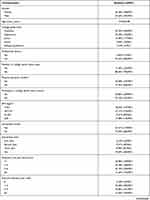 | 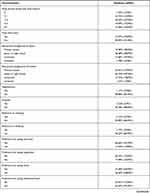 | 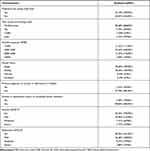 |
Table 1 Baseline Characteristics |
Subgroup Analysis
Compared with non-frequent sports dance students, frequent sports dance students significantly had more females (P=0.04), higher age P<0.01), higher college grade levels (P<0.01), more professional dancers (P<0.01), more scholarship winners (P<0.01), higher parental educational levels (P=0.02 and P=0.03), more students preferring to eat fruit (P=0.04), and lower depression score (P=0.04) (Table 2). Further, the non-frequent sports dance students were classified into two groups: participants in college sports dance courses and ordinary college students. When the three groups were compared together, similar results were obtained (Table 3). This confirmed that frequent sports dance students had the lowest depression score (P=0.06).
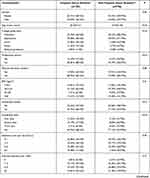 | 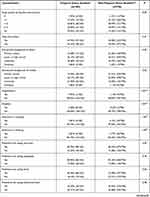 | 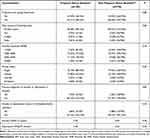 |
Table 2 Comparisons of Characteristics Between Frequent Dance and Non-Frequent Dance Students |
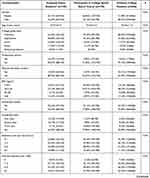 | 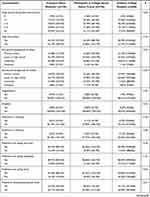 | 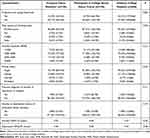 |
Table 3 Comparison of Characteristics Between Different Sports Dance Groups in College Students |
Risk Factors for Anxiety
According to multiple logistic regression models, college grade levels (OR=1.43, 95% CI: 1.21–1.68, P<0.01), physical education students (OR=0.66, 95% CI: 0.46–0.94, P=0.02), BMI (OR=1.18, 95% CI: 1.02–1.36, P=0.02), exercise frequency per week (OR=0.78, 95% CI: 0.66–0.93, P<0.01), addiction to drinking (OR=2.19, 95% CI: 1.14–4.21, P=0.02), and previous diagnosis of anxiety or depression in hospital (OR=3.58, 95% CI: 1.56–8.24, P<0.01) were significant, while other characteristics were not significant (Table 4). Namely, higher college grade levels, higher BMI values, addiction to drinking, and previous diagnosis of anxiety or depression were independent risk factors for anxiety, while being a physical education student and higher exercise frequency per week were independent protective factors for anxiety.
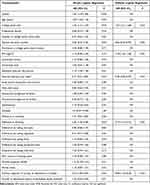 |
Table 4 Simple and Multiple Logistic Regression Analysis of Characteristics for Anxiety in University Students in China |
Risk Factors for Depression
Based on the multiple logistic regression models, college grade levels (OR=1.35, 95% CI: 1.15–1.59, P<0.01), member of college sports dance team (OR=0.55, 95% CI: 0.36–0.84, P<0.01), exercise frequency per week (OR=0.75, 95% CI: 0.65–0.87, P<0.01), only-child status (OR=0.68, 95% CI: 0.52–0.88, P<0.01), addiction to drinking (OR= 2.59, 95% CI: 1.35–5.00, P<0.01), preference for eating vegetables (OR=0.68, 95% CI: 0.49–0.95, P=0.02), preference for eating fried food (OR=1.39, 95% CI: 1.06–1.83, P=0.02), main source of drinking water (OR=1.28, 95% CI: 1.05–1.55, P=0.01), and previous diagnosis of anxiety or depression in hospital (OR=2.54, 95% CI: 1.11–5.81, P=0.03) were significantly associated with depression (Table 5). That is to say, higher college grade levels, addiction to drinking, preference for eating fried food, main source of drinking water (soda), and previous diagnosis of anxiety or depression were independent risk factors for depression, while member of college sports dance team, higher exercise frequency per week, only-child status, and preference for eating vegetables were independent protective factors for depression.
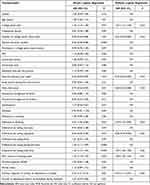 |
Table 5 Simple and Multiple Logistic Regression Analysis of Characteristics for Depression in University Students in China |
Effectiveness Evaluation of Significant Risk Factors
Figure 1 shows the ROC curves and C values of all six significant characteristics for anxiety. College grade levels had the highest C value, up to 0.65, followed by exercise frequency per week (0.61). When all six significant characteristics were combined, the C value was 0.77 and the correct classification rate was 94.5%, with a sensitivity of 28.0% and a specificity of 96.3% (Table 6). Figure 2 shows the ROC curves and C values of all six significant characteristics for depression. Exercise frequency per week showed the highest C value (0.65). The P-values obtained from the goodness-of-fit test were all above 0.05 in both the anxiety and depression models.
 |
Table 6 Evaluation of Models Including All Significant Characteristics |
Discussion
This study found that anxiety and depression were common among college students, after analyzing 901 students in China. Of all the participating students, 9.98% had moderate-to-severe anxiety and 14.65% suffered from moderate-to-severe depression. In other studies, 17.0–30% of college students suffered from anxiety and 12.2–19.9% had depression.2–6 The incidence of anxiety and depression varies among university students mainly because of the different evaluation tools and heterogeneity of populations. This study also demonstrated that frequent sports dance students had significantly lower depression scores than non-frequent sports dance students. According to the multiple logistic regression models, frequent sports dance also maintained significance for depression after adjusting for other potential risk factors. Thus, we concluded that frequent sports dance can serve as a protective factor for preventing depression. In a clinical trial conducted by Akandere and Demir21 in 2011, participants (120 healthy college students ranging from 20 to 24 years of age) were randomly classified into a dance training group (n=60) and a control group (n=60), and a dance training program was performed on 3 days a week for 12 weeks in the dance training group. The results showed that dance positively alleviated the depression levels in university students. More recently, Hellem et al22 evaluated the effect of OULA®, a dance fitness program, on depression in 53 women who had been diagnosed with major or persistent depressive disorders, and concluded that this was a useful intervention to decrease depression and anxiety severity. Our study was the first to analyze and confirm the effect of sports dance on mental disorders using real-world data in a series of 901 Chinese university students. In this real-world situation, all students voluntarily chose dance courses or took part in dance teams to practice dance skills, including waltz, tango, foxtrot, quickstep, and Latin. Students who participated in dance courses attended courses once a week, while members of dance teams practiced dance four times a week. There were also many students who did not attend any dance courses. According to our survey, 11.65% (105/901) were members of college sports dance teams, 21.09% (190/901) were participants in college sports dance courses, and 67.26% (606/901) ordinary college students did not attend any dance courses.
Furthermore, this study also found that higher college grade levels, addiction to drinking, preference for eating fried food, main source of drinking water (soda), and previous diagnosis of anxiety or depression were independent risk factors for depression, while higher exercise frequency per week, only-child status, and preference for eating vegetables were independent protective factors for depression. In other studies, some personal factors or detrimental behaviors, including Arab ethnicity,23 female gender,23,24 poor relationship with peers,23 higher year of study,23 poor academic performance,23 poor diet,25 lack of sports,25 sleep problems,25,26 alcohol abuse,27 non-compliance with doctor’s prescription,25 and maladaptive coping behavior,28 were found to be associated with depression. The above-mentioned studies enrolled a variety of populations, including medical students,23 adolescents,24 healthy people,25 second-year college students,26 first-year female college students,27 and Dutch service members.28 Our study supplemented the current and available literature. The results of our study may shed further light on strategies for preventing or alleviating depression, such as abstinence from drinking, healthy diet (eating less fried food, drinking less soda, and eating more vegetables), exercising more frequently, and appropriate treatment of previous anxiety or depression. Regarding risk factors for anxiety, we found that higher college grade levels, higher BMI values, addiction to drinking, and previous diagnosis of anxiety or depression were independent risk factors for anxiety, while being a physical education student and higher exercise frequency per week were independent protective factors for anxiety. Accordingly, management of weight, stopping drinking, treatment of previous anxiety or depression, and exercising more frequently may facilitate the prevention and treatment of anxiety among college students. Other studies also pointed out that female gender, poor body image, year of study, and poor academic performance were associated with increased anxiety symptoms.23,29 The current study found that the demands for preventing and intervening in mental disorders were high in college students. Overall, 9.98% students had moderate-to-severe anxiety and 14.65% students suffered from moderate-to-severe depression, according to our survey. Therefore, there is an urgent need to make necessary strategies available to help college students to prevent and handle anxiety and depression, such as participating in sports dance teams, having a healthy diet, exercising more frequently, management of weight, and appropriate treatment of previous anxiety or depression. In this study, we concluded that frequent dance positively alleviated the depression levels in university students. The reasons behind this may be that frequent sports dancers had more chance to be exposed to the active environment during dance practice, and physical well-being obtained from the exercise may also improve mental health.
However, this study has some limitations. First, since this is a study based on a survey, the evidence level of the study was not superior to the grade in clinical trials, as the clinical trials usually have a clinical evidence level of IV. Self-reported data was also a limitation in the study since participants may not be able to recall some essential information. Nonetheless, our study was the first to analyze the effect of dance on mental disorders using real-world data. Second, the reliability and validity of the data were not evaluated. However, we used standardized scales to evaluate the anxiety and depression status. Still, a large sample was needed for the investigation.
In conclusion, anxiety and depression are common among college students. Frequent sports dance may serve as a protective factor for preventing depression. Besides, lower college grade levels, being a physical education student, lower BMI, higher exercise frequency per week, only-child status, and preference for eating vegetables were independent protective factors for mental disorders. Conversely, addiction to drinking, preference for eating fried food, soda water served as the main drinking water, and previous diagnosis of anxiety or depression were independent risk factor for mental disorders.
Funding
This study was funded by the Fujian young teacher education research project (no. JAS170328).
Disclosure
The authors declare that they have no conflicts of interest.
References
1. Auerbach RP, Alonso J, Axinn WG, et al. Mental disorders among college students in the World Health Organization World Mental Health Surveys. Psychol Med. 2016;46(14):2955–2970. doi:10.1017/S0033291716001665
2. Beiter R, Nash R, McCrady M, et al. The prevalence and correlates of depression, anxiety, and stress in a sample of college students. J Affect Disord. 2015;173:90–96. doi:10.1016/j.jad.2014.10.054
3. Fortney JC, Curran GM, Hunt JB, et al. Prevalence of probable mental disorders and help-seeking behaviors among veteran and non-veteran community college students. Gen Hosp Psychiatry. 2016;38:99–104. doi:10.1016/j.genhosppsych.2015.09.007
4. Ghrouz AK, Noohu MM, Dilshad Manzar M, Warren Spence D, BaHammam AS, Pandi-Perumal SR. Physical activity and sleep quality in relation to mental health among college students. Sleep Breath. 2019;23(2):627–634. doi:10.1007/s11325-019-01780-z
5. Oswalt SB, Lederer AM, Chestnut-Steich K, Day C, Halbritter A, Ortiz D. Trends in college students’ mental health diagnoses and utilization of services, 2009–2015. J Am Coll Health. 2020;68(1):41–51. doi:10.1080/07448481.2018.1515748
6. Eisenberg D, Gollust SE, Golberstein E, Hefner JL. Prevalence and correlates of depression, anxiety, and suicidality among university students. Am J Orthopsychiatry. 2007;77(4):534–542. doi:10.1037/0002-9432.77.4.534
7. Lew B, Huen J, Yu P, et al. Associations between depression, anxiety, stress, hopelessness, subjective well-being, coping styles and suicide in Chinese university students. PLoS One. 2019;14(7):e0217372. doi:10.1371/journal.pone.0217372
8. Fong Yan A, Cobley S, Chan C, et al. The effectiveness of dance interventions on physical health outcomes compared to other forms of physical activity: a systematic Review and meta-analysis. Sports Med. 2018;48(4):933–951. doi:10.1007/s40279-017-0853-5
9. Wang Z, An G, Zhang W, Yang G. The effect of jazz dance on physical and mental health of students with different physical fitness. J Sports Med Phys Fitness. 2019;59(5):880–885. doi:10.23736/S0022-4707.18.08025-8
10. Guo S, Liu F, Shen J, Wei M, Yang Y. Comparative efficacy of seven exercise interventions for symptoms of depression in college students: a network of meta-analysis. Medicine (Baltimore). 2020;99(47):e23058. doi:10.1097/MD.0000000000023058
11. Allet L, Muller-Pinget S, Punt I, et al. Dance therapy combined with patient education improves quality of life of persons with obesity: a pilot feasibility study for a randomised controlled trial. Obes Res Clin Pract. 2017;11(1):79–87. doi:10.1016/j.orcp.2016.03.005
12. Conceicao LS, Neto MG, Do Amaral MA, Martins-Filho PR, Oliveira Carvalho V. Effect of dance therapy on blood pressure and exercise capacity of individuals with hypertension: a systematic review and meta-analysis. Int J Cardiol. 2016;220:553–557. doi:10.1016/j.ijcard.2016.06.182
13. Filar-Mierzwa K, Dlugosz M, Marchewka A, Dabrowski Z, Poznanska A. The effect of dance therapy on the balance of women over 60 years of age: the influence of dance therapy for the elderly. J Women Aging. 2017;29(4):348–355. doi:10.1080/08952841.2016.1194689
14. de Natale ER, Paulus KS, Aiello E, et al. Dance therapy improves motor and cognitive functions in patients with Parkinson’s disease. NeuroRehabilitation. 2017;40(1):141–144. doi:10.3233/NRE-161399
15. Koch SC, Riege RFF, Tisborn K, Biondo J, Martin L, Beelmann A. Effects of dance movement therapy and dance on health-related psychological outcomes. A meta-analysis update. Front Psychol. 2019;10:1806. doi:10.3389/fpsyg.2019.01806
16. Mansfield L, Kay T, Meads C, et al. Sport and dance interventions for healthy young people (15–24 years) to promote subjective well-being: a systematic review. BMJ Open. 2018;8(7):e020959. doi:10.1136/bmjopen-2017-020959
17. Hsieh FY. Sample size tables for logistic regression. Stat Med. 1989;8(7):795–802. doi:10.1002/sim.4780080704
18. Borghero F, Martinez V, Zitko P, Vohringer PA, Cavada G, Rojas G. Screening depressive episodes in adolescents. Validation of the Patient Health Questionnaire-9 (PHQ-9). Rev Med Chil. 2018;146(4):479–486. Spanish. doi:10.4067/s0034-98872018000400479
19. Lowe B, Decker O, Muller S, et al. Validation and standardization of the Generalized Anxiety Disorder Screener (GAD-7) in the general population. Med Care. 2008;46(3):266–274. doi:10.1097/MLR.0b013e318160d093
20. Bartolo A, Monteiro S, Pereira A. Factor structure and construct validity of the Generalized Anxiety Disorder 7-item (GAD-7) among Portuguese college students. Cad Saude Publica. 2017;33(9):e00212716. doi:10.1590/0102-311x00212716
21. Akandere M, Demir B. The effect of dance over depression. Coll Antropol. 2011;35(3):651–656.
22. Hellem T, Sung YH, Ferguson H, Hildreth L. The emotional dance with depression: a longitudinal investigation of OULA(R) for depression in women. J Bodyw Mov Ther. 2020;24(4):413–422. doi:10.1016/j.jbmt.2020.05.007
23. Mahroon ZA, Borgan SM, Kamel C, Maddison W, Royston M, Donnellan C. Factors associated with depression and anxiety symptoms among medical students in Bahrain. Acad Psychiatry. 2018;42(1):31–40. doi:10.1007/s40596-017-0733-1
24. Crockett MA, Martinez V, Jimenez-Molina A. Subthreshold depression in adolescence: gender differences in prevalence, clinical features, and associated factors. J Affect Disord. 2020;272:269–276. doi:10.1016/j.jad.2020.03.111
25. Doom JR, Haeffel GJ. Teasing apart the effects of cognition, stress, and depression on health. Am J Health Behav. 2013;37(5):610–619. doi:10.5993/AJHB.37.5.4
26. Wallace DD, Boynton MH, Lytle LA. Multilevel analysis exploring the links between stress, depression, and sleep problems among two-year college students. J Am Coll Health. 2017;65(3):187–196. doi:10.1080/07448481.2016.1269111
27. Rosenthal SR, Clark MA, Marshall BDL, et al. Alcohol consequences, not quantity, predict major depression onset among first-year female college students. Addict Behav. 2018;85:70–76. doi:10.1016/j.addbeh.2018.05.021
28. de Kruijff LGM, Moussault ORM, Plat MJ, Hoencamp R, van der Wurff P. Coping strategies of Dutch servicemembers after deployment. Mil Med Res. 2019;6(1):9. doi:10.1186/s40779-019-0199-4
29. Gao W, Ping S, Liu X. Gender differences in depression, anxiety, and stress among college students: a longitudinal study from China. J Affect Disord. 2020;263:292–300. doi:10.1016/j.jad.2019.11.121
 © 2021 The Author(s). This work is published and licensed by Dove Medical Press Limited. The full terms of this license are available at https://www.dovepress.com/terms.php and incorporate the Creative Commons Attribution - Non Commercial (unported, v3.0) License.
By accessing the work you hereby accept the Terms. Non-commercial uses of the work are permitted without any further permission from Dove Medical Press Limited, provided the work is properly attributed. For permission for commercial use of this work, please see paragraphs 4.2 and 5 of our Terms.
© 2021 The Author(s). This work is published and licensed by Dove Medical Press Limited. The full terms of this license are available at https://www.dovepress.com/terms.php and incorporate the Creative Commons Attribution - Non Commercial (unported, v3.0) License.
By accessing the work you hereby accept the Terms. Non-commercial uses of the work are permitted without any further permission from Dove Medical Press Limited, provided the work is properly attributed. For permission for commercial use of this work, please see paragraphs 4.2 and 5 of our Terms.

